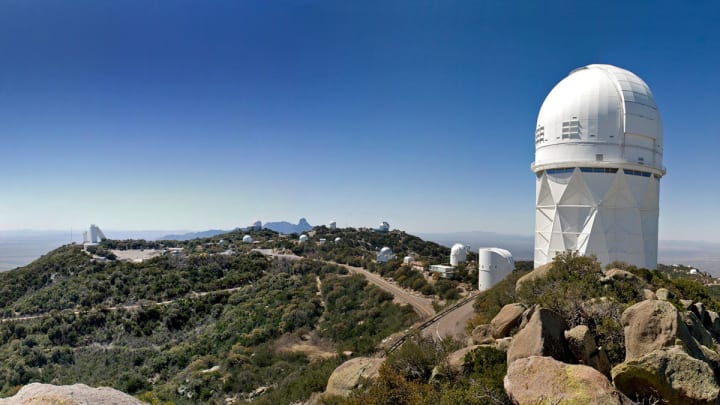Observatory Guide
Observatories all over the country offer astronomers, from beginners to professionals, a chance to visit our solar system without leaving Earth.

There are few pastimes more fascinating, more mysterious, or more peaceful than simply stargazing at a splendid night sky—wondering what it all means. Will we ever travel to any of those other suns? Are there other souls like us on a distant planet, looking up and wondering the same? A special breed of investigator is devoted to finding the answers to some of these questions, by studying everything in the universe from the movement of planets to the nature of such bizarre objects as quasars and black holes, which explode or go beep in the night. That investigator is the astronomer.
A telescope is essentially a huge bucket for gathering light, the larger the bucket the more light it can gather—and the fainter the objects it can detect. Although a century ago most astronomers spent their observing time actually looking through the telescope, today they seldom do. Instead, the light from the object of curiosity is captured on a photographic plate or is directed through a prism that breaks it up into a rainbow of colors, which becomes the individual signature of the object's internal chemistry.
If you have ever wondered how astronomers are able to measure what is happening in the next galaxy, you might be surprised to learn that many observatories welcome visits from the interested public. Some observatories employ college students to conduct guided tours of their facilities, usually during the daytime, and to answer questions about the institution's research. Other facilities feature public observing nights during clear weather—evenings when you are given the chance to look through a medium-size telescope at the craters of the moon, the rings of Saturn, or some multicolored luminous cloud of gas in the depths of space.

Photo via Expedia
What to Know
There are hundreds of observatories sprinkled across the nation, ranging in size from modest college installations to major research facilities. You don't have to be an astronomer to enjoy a tour of one: Half the thrill of gazing up at a steel-and-glass telescope six stories high is simply being awed by this magnificent piece of human engineering, which runs with finer precision than a Swiss watch.
Admission to an observatory is generally free, although frequently visitors must call for advance reservations because of limited space. It is usually a good idea to take a lunch and fill your gas tank before embarking on your visit because observatories tend to be isolated; It can be a long way to the nearest Coke machine, and if you run out of fuel, towing charges are fierce.
Dress warmly. The huge mirrors or lenses of the telescopes must be kept at nighttime temperatures during the day, so observatories are unheated even on the chilliest days. In fact, in the domes of the largest telescopes, visitors are usually confined to glassed-in galleries because hundreds of tourists' warm bodies trooping under the optics all day would render the telescope useless for work that night.

Photo via Lick
Where to Go
Lick Observatory in Mount Hamilton, California
Located 30 kilometers of winding road east of San Jose is Lick Observatory. It began its operations in 1888 and has since gone on to service astronomers from all eight University of California campuses, as well as two national laboratories. Boasting an impressive 36" Great Refractor, the observatory is a destination for many astronomers, from the amateur to the veteran. Additional active technology includes the Shane 120" Reflector, Nickel 1-meter Reflector, Katzman Automatic Imaging Telescope, and Automated Planet Finder.
Plan your trip to Lick Observatory.
Hale Observatories in Southern California
Actually, they are two sister installations at different sites: one is at Mount Wilson, northeast of Los Angeles, and the other is on Palomar Mountain, between Los Angeles and San Diego. In their time, each sported the largest telescope in the world: The two-and-a-half-meter reflector at Mount Wilson held the title from 1919 until the five-meter reflector was installed on Palomar Mountain in 1949.
Palomar Observatory is owned and operated by the California Institute of Technology (Caltech). Boasting three active telescopes used for research, the 200" (5.1 meter) Hale Telescope, the 48" (1.2 meter) Samuel Oschin Telescope, and the 60" telescope. The facility is used for student training, research, and instrument development and has been a leader in the field since mid century.
Plan your trip to Palomar Observatory.
Mount Wilson Observatory is home to a 60" telescope and a 100" Hooker telescope. Both provide beautiful and incredible views of the night sky and all of its inhabitants. The larger of the two, as mentioned above, was the largest telescope in the world from 1919 to 1949 and has the reputation of aiding some of the greatest astronomers of the 20th century.
Plan your trip to Mount Wilson Observatory.
Kitt Peak National Observatory in Tucson, Arizona
In Arizona, this is a prime site for astronomical observing. Affectionately known to some as "Telescope National Forest," Kitt Peak sports the densest concentration of astronomical instruments in the world, totaling at 24 optical and two radio telescopes. The unique hallmark of the Kitt Peak Observatory is the McMath solar telescope, which from a distance looks like a sleek white upside-down check mark: a vertical white tower 11 stories high supporting a slanting shaft 20 stories long. This shaft forms a 150-meter light path for the beam of sunlight that, when it finally comes to a focus in the observing room underground, forms an image of the sun nearly a meter across. The McMath-Pierce telescope is the largest solar telescope in the world. Additionally there is the Mayall 4-meter, the WIYN 3.5 meter, and the ARO 12 meter Radio Telescopes.
Plan your trip to Kitt Peak National Observatory.

Photo via The Wall Street Journal
Lowell Observatory in Flagstaff, Arizona
Founded in the 90s by Boston Brahmin Percival Lowell (the brother of the poet Amy Lowell) for the express purpose of looking for canals on Mars, which Lowell thought might be evidence of an intelligent race. Much of the work of the Lowell Observatory is still concerned with the solar system, and the planet Pluto was discovered there in 1930. Set back in a peaceful pine forest on a hill at the west end of town, it is one of the few major observatories that can be easily reached by public transportation. Lowell is home to many impressive telescopes, including the 4.3-meter Discovery Channel Telescope, 1.8-meter Perkins, Navy Precision Optical Interferometer, and several others.
Plan your trip to Lowell Observatory.
McDonald Observatory on Mount Locke, Texas
Located in Fort Davis on Mount Locke, the McDonald Observatory lies under some of the darkest skies in the United States. Its research and administrative home is the University of Texas at Austin. Hosting one of the nation’s most productive lunar ranging stations, it is also home to the 10-meter Hobby-Eberly, 2.7-meter Harlan J. Smith, 2.1-meter Otto Struve telescopes, as well as many others.
Plan your trip to McDonald Observatory.
Yerkes Observatory in Williams Bay, Wisconsin
The best site for an observatory of course, is one away from city lights and smog, where the air is steady and it doesn't rain half the year. For those reasons, the largest modern research institutions are in the American Southwest. Nonetheless, there are plenty of observatories elsewhere in the country, particularly ones of historical interest. This observatory, which was established in 1897, is famous for its 99-centimeter Clark refractor, the largest lens-telescope in the world. Edwin Hubble, for whom the Hubble Space Telescope was named, did his graduate work at Yerkes Observatory, as well as Subrahmanyan Chandrasekhar, Otto Struve, and Carl Sagan.
About the Creator
Futurism Staff
A team of space cadets making the most out of their time trapped on Earth. Help.






Comments
There are no comments for this story
Be the first to respond and start the conversation.